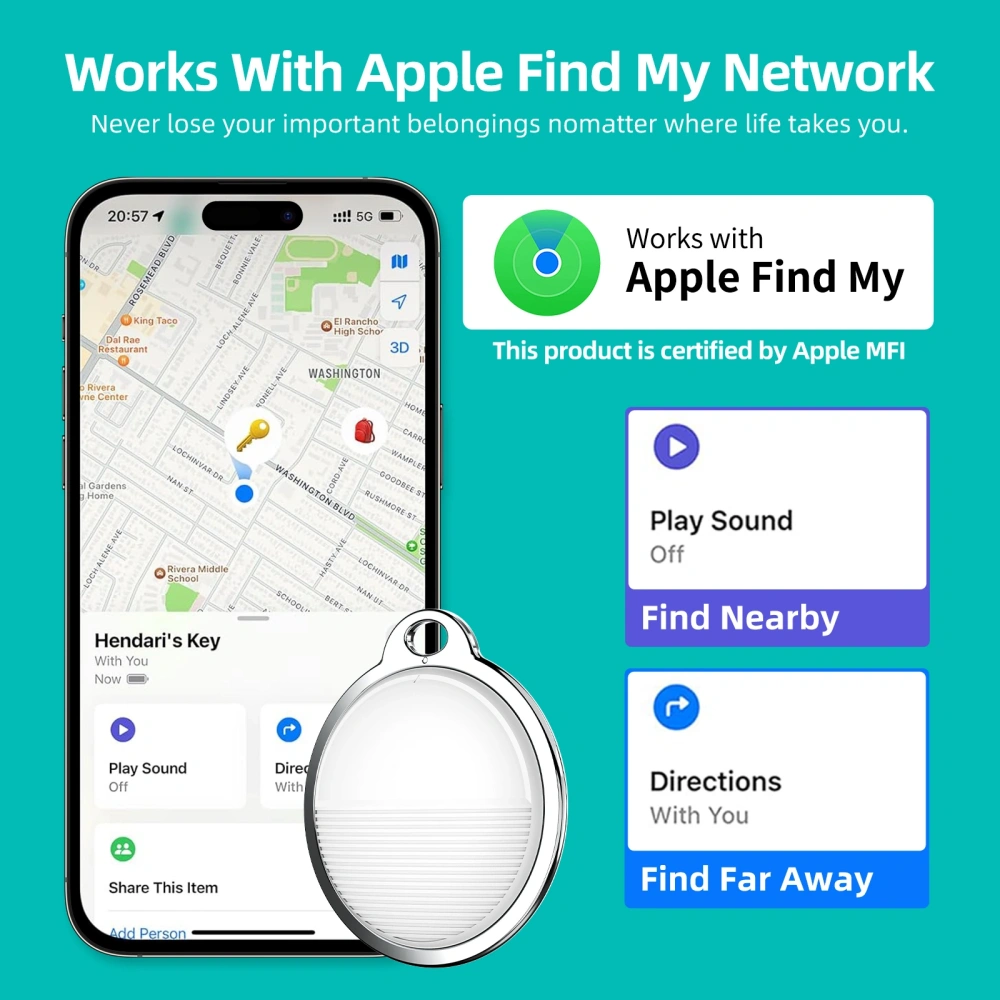Never Forget: The Ultimate Guide to keeping track of Keys, wallets, and other small items
‘where did I put my keys? ‘ ‘did I leave my wallet at the coffee shop? ‘ — these are daily soul-searching exercises that leave us in a state of anxiety. The good news is that technology has come up with a straightforward solution: tracking gadgets is no longer a problem. This article will be a comprehensive analysis of the mainstream of small tracking technology and products, hand-in-hand to teach you according to demand to choose the most suitable“Anti-lost device.”.
![]()
Part 1: core technology analysis-two mainstream tracking solutions
The technology for tracking small objects boils down to two core solutions, based on different positioning logics, covering the whole scene from“Looking for keys at home” to“Looking for luggage around the world.”. Among them, the Bluetooth tracker is subdivided into two categories, function and price difference is significant, the choice should pay special attention.
Solution 1: Bluetooth Trackers/Smart Tags — the king of near-field and community finders
Bluetooth trackers are currently the most popular choice for small items such as keys and wallets, but not all bluetooth trackers are“Lost and found”.
(1) a basic bluetooth tracker that only supports close-up lookups
These are the mainstays of low-cost bluetooth trackers (usually available for less than $10) , which are limited to“Finding things within sight.”.
![]()
How it works:
You connect directly to the phone only via Bluetooth low energy (BLE) , and within the Bluetooth range (usually 10-30 meters, which is affected by obstacles such as walls) , you can let the Tracker make a beep on the App, or you can determine the approximate distance by signal strength. No long-range location at all — once an item goes out of Bluetooth range, the phone displays only“Last connected location,” and no new information is available.
Pros:
The price is low enough to fit multiple gadgets (like each remote control) .
Small enough to make a button-sized sticker that won’t stick out anywhere.
It doesn’t need to be connected to the internet and works just fine in the basement and other areas where there is no signal.
Cons:
Single function, can only solve the“At home to find the remote control” this kind of fixed scene problem.
Once an item is taken out of Bluetooth range (such as left at a friend’s house or in a shopping mall fitting room) , it will be completely“Lost”.
What You’ll need:
Small stationary items in the home (TV remote, garage remote) , or locating luggage in a hotel room while traveling.
(2) advanced Bluetooth tracker with community finder network (crowdsourced location)
![]()
These are the real“Smart Tags” that can be“Lost and found”, and are the core form of what we call“Anti-lost devices”.
How it works:
It has dual functions of“Close search” and“Distant Community Search”:
Up Close: the same as the base model, it uses a direct Bluetooth connection to let the tracker make sounds and check signal strength (typically 15-80 meters, for a more stable signal) .
Community Finder Networks (crowdsourced location) : when items are lost beyond Bluetooth range, their location is anonymously detected and uploaded via an“Invisible network” of mobile phones belonging to the same brand/ecosystem across the globe. If your lost AirTag is taken to another city, it can automatically send its location back to your phone whenever an iPhone user is nearby.
Pros:
Both“Near-field precision search” and“Far-field global search”, from“Home to find the key” to“Cross-border search baggage” can be covered.
Super Endurance, with a button battery can last 1-2 years (partially replaceable battery) , almost no maintenance.
Feature-rich: support“Two-way Search”(press the tracker to make silent mobile phone ring) , “Separation Reminder”(items out of range when the mobile phone alarm) and other practical functions.
Most no follow-up costs, a purchase of life-long use of the basic positioning function.
Cons:
Prices are higher than the base model (usually 15-50) because of the need to access the brand’s global positioning network.
Long-range location relies on“Community density,” and in remote rural areas (with fewer cell phone users) the effect is diminished.
Location updates are not real-time and require waiting for other users’ phones to“Stumble” on the missing tracker.
For ecology and product:
Apple Find My ecosystem: Apple AirTag and third-party certified products (Chipolo ONE Spot, Belkin Soundform) , with hundreds of millions of Apple devices, the world’s most extensive network.

Google Find My Device ecosystem: for Android users, Pebblebee Clip, EUFY SmartTrack and other brands have joined to leverage the huge base of Android devices for rapid growth.
Independent Brand Ecology: Tile, Cube, etc. . The advantage is cross-platform (available for both Apple and Android) , with some support for historical track queries.
What You’ll need:
Keys, wallets, backpacks and other personal belongings that may be taken out of the daily range, as well as important travel items such as luggage.
Scheme Two: Mini GPS trackersーー a powerful choice for active real-time positioning
If your“Gadget” is of high value (e.g. , a valuable briefcase, a professional device) or needs real-time tracking (e.g. , a pet, a drone) , a tiny GPS tracker will be more reliable.
How it works:
The device has a built-in GPS module and SIM card, which can receive satellite signals to get a precise location (usually within 5-10 meters) , and then use a cellular network (4G/NB-IoT) to actively send the location data to the mobile App for real-time tracking.
Pros:
Active real-time tracking: whenever you have a cell phone signal, you can update your location in real time, whether it’s on a city street or a remote road.
Features: support electronic fence (leave a specific area of alarm) , historical track playback (view the past 30 days path) , SOS emergency call.
Cons:
Higher costs: hardware costs typically start at 50 and include a monthly data fee (1-$5/month) .
Short battery life: due to the need for GPS positioning and network communication, most of the 1-7 days of battery life, the need for regular charging.
Slightly larger: usually about the size of a matchbox, not as portable as a bluetooth tracker.
What You’ll need:
Pets (especially those in the wild) , bikes, drones, expensive equipment, and other items that require real-time location control.
Part 2: A Contextual Guide to choosing-which to choose?
| Tracking items | Recommended Solution | Reasons |
| TV remote, garage remote | Basic Bluetooth tracker for close proximity only | Low Price (can buy more) , only need to solve the“Find at home” problem, no remote function. |
| Keys, Wallet, badge | Advanced Bluetooth tracker with social networking | Can be taken out of range, requires“Remote retrieval” capability, and needs to be small. |
| Backpacks, laptop bags, luggage | Advanced Bluetooth tracker with social networking | May be lost in public places (airports, subways) , social network“Encounter location” can improve the probability of recovery, and no subsequent costs. |
| Pets (mostly in cities) | Advanced Bluetooth tracker with social networking | There are enough cell phone users to go around, separate reminders to keep you from getting lost, and social networks to help you find it. |
| A pet, ie one who often goes to the wild or the country | Tiny GPS trackers | Activity areas are sparsely populated, social networks are ineffective, and active GPS positioning is required to ensure they are found. |
| Bicycles, electric scooters | Tiny GPS trackers | High demand for anti-theft, real-time tracking of the stolen location, Bluetooth tracker is easy to be removed and can not take the initiative to locate. |
| Unmanned aerial vehicles, valuable equipment boxes | Tiny GPS trackers | High value and can be lost in areas without cell phone signal, active GPS positioning can be accurate to specific coordinates. |
Part 3: Getting Started-3 steps to fixing your anti-lost gadget
Whichever tracker you choose, the setup is simple and takes about three minutes:
Activate and match:
Basic Bluetooth tracker: RIP off the battery insulation, open up the phone’s Bluetooth and the corresponding App (usually a simple manufacturer’s App) , click“Search device”, and you’re ready to use it (no internet connection required) .
Advanced Bluetooth tracker: after booting up, add the device to your phone’s ecosystem App (like Apple’s Find) or brand-specific App, and follow the prompts to complete the pairing (you’ll need to connect to the Internet to activate the community feature) .
Micro GPS Tracker: Plug in a SIM card (some built-in ESIM doesn’t require a SIM card) , charge and boot, enter device ID into the App, wait 5-10 minutes to get a GPS signal (it may be a little slow to use at first) .
Naming and personalization:
Name each device in the App (e.g. “House key” or“Black wallet”) to make it easier to tell one from the other, and the advanced bluetooth tracker enables“Separation alerts”(setting the appropriate distance, e.g. the key is 5 meters away from the body) .
Explore the core features:
BASIC: click“Make sounds” directly in the App to find items with sounds.
Advanced: look for“Vocalization” or“Signal strength” at close range; look for“Last known position” at a distance, then switch to“Pinpoint” when you’re near it.
Micro GPS: View real-time location in the App, set up electronic fences (e.g. alarm for pets leaving home 100 meters away) , view historical tracks.
![]()
Verdict: choose on demand, making“Looking for things” a thing of the past
The essence of the“Low” and“High” price of Bluetooth tracker is the difference of function boundary: the basic model solves the problem of“Looking for things in sight”, which is suitable for fixed scenes; the advanced model solves the problem of“Lost can be found”, which is suitable for portable items. The micro GPS is an“Active control” option, suitable for high-value, high-risk scenarios.
Spend $10 on a basic remote control to avoid rummaging around the house; spend $30 on a more advanced key that you don’t have to double-check when you go out; spend $30 on a GPS device for a pet that goes out in the wild a lot, ease into it-by choosing items based on their importance and the context in which they are used, you can end the anxiety of“Missing something” at the lowest cost and make your life easier.







